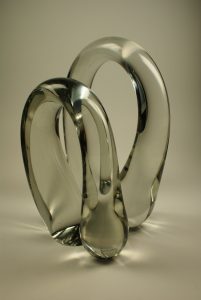STUDIO GLASS CABINET: Harvey K. Littleton - German/German

Studio glass stands for a historical movement that had its peak at the end of the 1950s until the 1980s. Studio glass means an artistic and thus non-purposeful and non-functional processing of glass. A decisive step in this direction was the invention of the studio glass furnace - a small glass melting furnace in which 50 to 80 kilograms of glass can be melted. That is exactly the amount that can be processed in one day. Now it was possible for artists to work freely and independently of the smelter - an advantage especially for women who were not allowed to work at the smelter. The studio glass furnace created the prerequisite for glass classes to be set up in short succession at art academies and art colleges, especially in the USA, and for artists to be able to work on their own in their workshops.
The co-inventor of the studio kiln was the American Harvey K. Littleton. With his kiln and his work also at German art academies and symposia, he made a decisive contribution to the spread and international establishment of the studio glass movement. Above all, because he introduced the medium of glass into art as a means of design. In the process, form takes on a completely new meaning: it becomes glass sculpture.
Littleton's "Loops" or "The Bowers" from 1974 show the pure joy in the character of the material glass. The curved forms seem like masses of paint squeezed out of a tube. They illustrate nothing other than the malleability of glass and its solidification in the middle of the creative and flowing process. The artist captures a section of the working process, the flowing of glass, and thus makes it visible.
STUDIO GLASS Cabinet: Harvey K. Littleton - English

Studio Glass Is the name given to a historical movement that reached its high point at the end of the 1950s and continued into the 1980s. Studio glass means a free artistic processing of glass that is not related to purpose or function. The invention of the studio glass furnace was a decisive step in this direction. It was a small glass furnace in which 50 to 80 kg of glass could be melted. This is the exact amount that one person can process in a day and it meant artists were free from and independent of glass foundries - an advantage for women especially, who were not allowed to work at a foundry furnace. The studio glass furnace enabled artists to work alone in their own workshops and set off a chain reaction that led to glass courses being offered at art academies and arts colleges in the USA especially.
An American called Harvey K. Littleton was the co-inventor of the studio glass furnace. This and his works meant he was instrumental in the international establishment and popularity of the studio glass movement, also at German art academies and symposia. Above all though because he introduced the medium of glass to art as a design material, and the shaping of it took on a new meaning: it became glass sculpture.
Littleton's "Loops" or "the bowing," from 1974 demonstrate his pure joy in the character of glass. The curved forms look like paint that have been squeezed out of a tube and they illustrate nothing else than the malleability of glass and its solidification in the middle of the creative and flowing process.
The artist captures a section of the working process, the flowing of glass, and makes it visible.